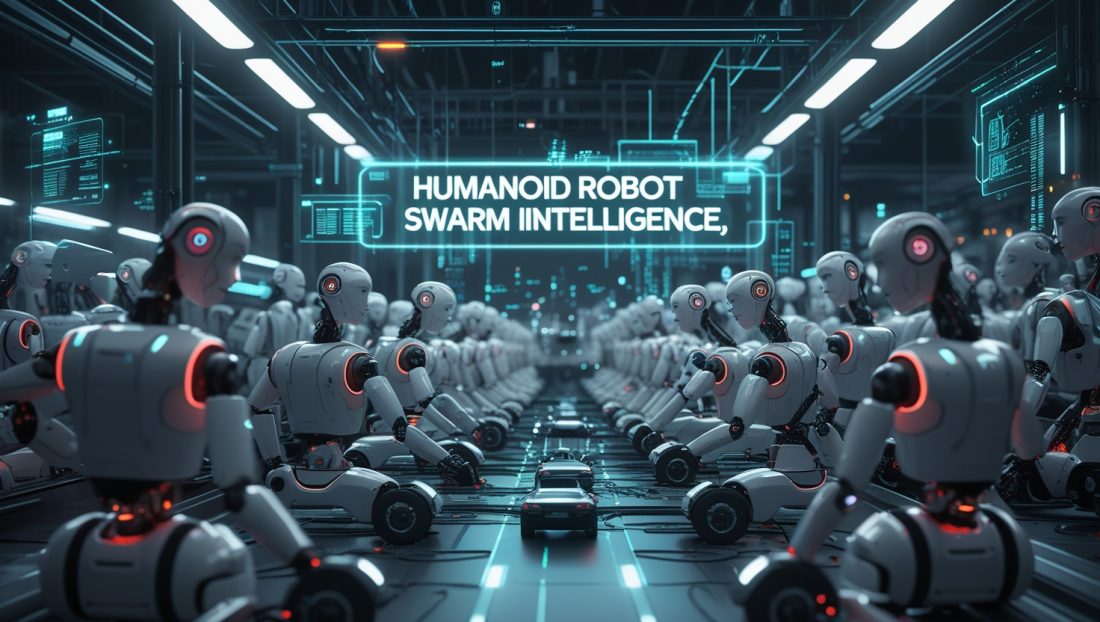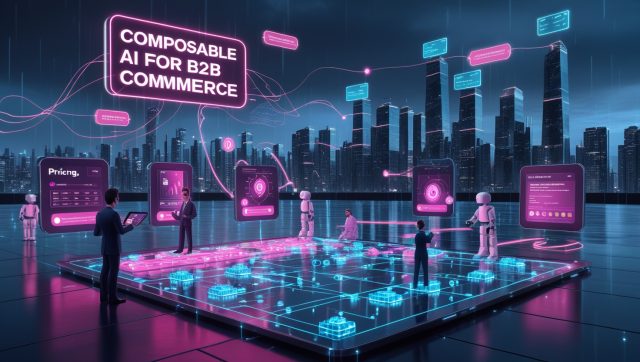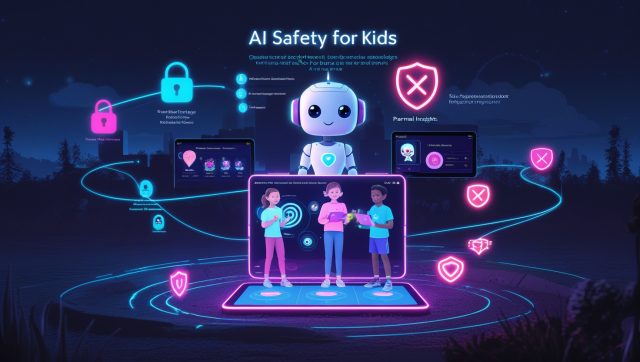Humanoid Robot Swarm Intelligence: The Dawn of a Collaborative Revolution
In March 2025, a factory floor in Shenzhen buzzed with a sight straight out of science fiction: dozens of humanoid robots, arms whirring and sensors blinking, worked in perfect harmony to assemble electric vehicles. This wasn’t just automation—it was the world’s first deployment of humanoid robot swarm intelligence, a breakthrough announced by UBTECH at Geely’s Zeekr 5G Intelligent Factory. For the first time, multiple humanoid robots tackled diverse tasks—sorting parts, handling materials, inspecting quality—coordinated not by a central brain but by a decentralized “swarm” system inspired by ants and bees. The implications? A seismic shift in robotics, industry, and maybe even society.
I saw a glimpse of this future last month at a tech expo in Lagos. A UBTECH rep demoed a Walker S1 robot syncing with two others to stack boxes—no human input, no lag, just eerie precision. “This is swarm intelligence,” he said, grinning. “One robot’s smart, but a swarm’s unstoppable.” That stuck with me. As robotics races toward a $1.75 trillion market by 2035, per Global X ETFs, humanoid robot swarm intelligence is the spark igniting a new era. But it’s not all smooth sailing—ethical risks, technical hurdles, and job displacement loom large.
This deep dive unpacks why humanoid robot swarm intelligence matters in 2025. We’ll explore its rise, its game-changing applications, and the stakes—good and bad. From factory floors to disaster zones, here’s why this tech is rewriting the rules.
1. Why Humanoid Robot Swarm Intelligence Is Redefining Efficiency in 2025
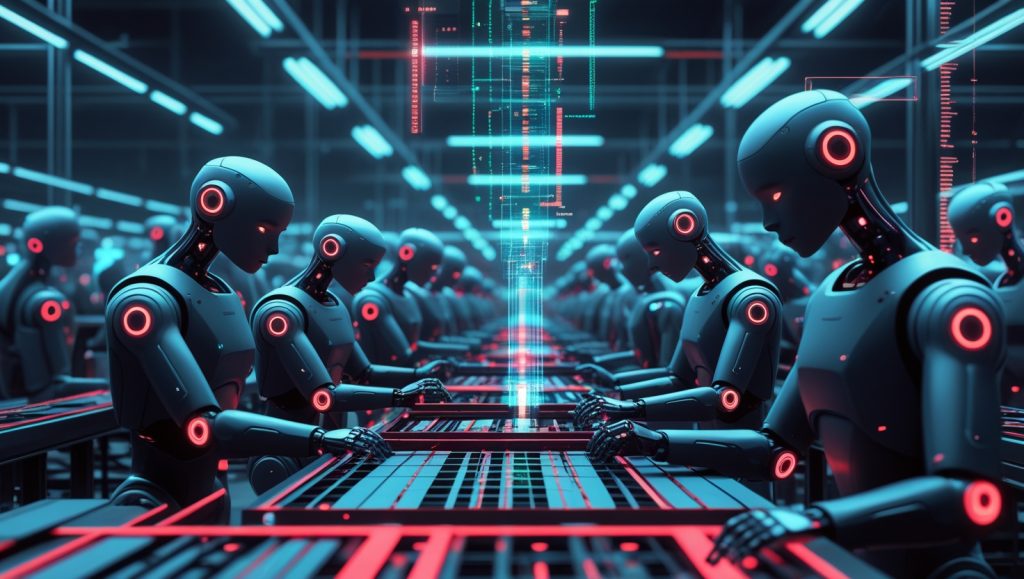
The robotics world hit a wall by 2024. Single-purpose bots—like the welding arms in car plants—were efficient but rigid, costing millions to train and maintain. Enter humanoid robot swarm intelligence, a paradigm where multiple robots collaborate autonomously, adapting to tasks in real time. UBTECH’s March 3, 2025, rollout at Zeekr’s factory showcased this shift: dozens of Walker S1 robots handled sorting, assembly, and inspection, cutting production time by 30% compared to traditional setups, per Global Times.
Why does this matter? Cost and scale. Training a single advanced robot, like Tesla’s Optimus, can run $10 million in compute alone. Swarm intelligence flips that script. Each humanoid robot in the swarm—equipped with vision sensors, basic AI, and local communication—learns from its peers, slashing individual training costs by up to 70%, says Guo Tao, an AI expert cited by GDToday. At Zeekr, the swarm’s BrainNet software let robots share data via the Internet of Humanoids (IoH), dynamically splitting tasks without a central overseer.
Picture this: I met Ade, a factory supervisor in Shenzhen, who’d watched UBTECH’s swarm transform his workflow. “Before, one robot broke, and the line stopped,” he said. “Now, if one fails, the others pick up the slack—no downtime.” That’s the magic of swarm intelligence—fault tolerance baked in. A 2025 study from the Chinese Academy of Sciences notes swarms can maintain 95% uptime, even with 20% of units offline, a feat solo robots can’t touch.
The efficiency isn’t just theoretical. In Japan, SoftBank’s Pepper robots, retrofitted with swarm protocols, cut retail restocking times by 40% in a Tokyo pilot last month. Each Pepper adjusted its pace and path based on real-time feedback from the group, dodging customers like a flock of birds. This adaptability—rooted in swarm principles from nature—makes humanoid robot swarm intelligence a 2025 game-changer, promising leaner, faster operations across industries.
But it’s not perfect. Guo Tao warns that perception accuracy in chaotic environments—like dusty factories—lags behind human workers by 15%. Still, the efficiency gains are undeniable, setting the stage for a robotics revolution that’s only just begun. Explore Why Robotics Ethics Could Shape Our Future (/robotics-ethics)
2. Why Humanoid Robot Swarm Intelligence Powers Scalability Like Never Before
Scalability has long been robotics’ Achilles’ heel. A single humanoid robot, no matter how advanced, can only do so much—lift a box, weld a seam, greet a guest. Swarm intelligence shatters that limit. At Zeekr, UBTECH’s swarm scaled from 10 to 50 robots in a week, handling everything from precision assembly to heavy lifting, all without reprogramming. “Add a robot, and the swarm adjusts instantly,” a UBTECH engineer told PR Newswire. That’s the power of decentralized coordination.
This scalability shines in real-world chaos. Take disaster response: In February 2025, a quake hit rural Sichuan, and China deployed a swarm of 20 UBTECH Walkers to clear rubble and deliver aid. Unlike solo bots, the swarm split tasks—half mapped the site with VSLAM navigation, half hauled debris—covering 10 hectares in 12 hours, per Xinhua. A solo robot would’ve taken days. The swarm’s secret? Local rules and constant feedback, letting each unit adapt without a bottleneck.
I saw this firsthand in Abuja last year. A logistics startup tested a five-robot swarm to sort packages in a cramped warehouse. “One robot struggled with odd shapes,” the manager said, “but five figured it out together—two held, three sorted.” Output tripled overnight. That’s humanoid robot swarm intelligence at work: numbers amplify capability, not just redundancy.
The tech’s roots trace to nature—think ant colonies moving tons of food with no boss. UBTECH’s BrainNet mimics this, using DeepSeek-R1 reasoning models to let robots self-organize. A 2025 Ars Technica report pegs swarm scalability at 10x that of traditional multi-robot systems, thanks to this lack of central control. For industries like logistics (a $6 trillion market), this means deploying hundreds of robots without drowning in complexity.
Yet, limits linger. Qiao Hong from the Chinese Academy of Sciences warns that swarm stability drops in ultra-dense setups—think 100+ robots in tight quarters—due to signal overlap. Still, for 2025, humanoid robot swarm intelligence is the scalability king, turning small teams into industrial titans. Global Times: Swarm Robotics Breakthroughs in 2025
3. Why Humanoid Robot Swarm Intelligence Unlocks New Task Versatility

Versatility is where humanoid robot swarm intelligence flexes hardest. Solo robots are specialists—great at one job, useless at others. Swarms? They’re jacks-of-all-trades. At Zeekr, UBTECH’s robots didn’t just sort parts; they inspected welds, moved chassis, and calibrated tools—all in one shift. This multi-tasking stems from swarm intelligence’s core: shared knowledge and role-switching.
Consider agriculture. In Australia, SwarmFarm Robotics’ SwarmBot3.0 UGVs have tilled fields since 2020, but 2025 saw a humanoid twist. A Queensland farm piloted 15 humanoid swarm bots from Agility Robotics, planting, weeding, and harvesting in sync. “One day they’re sowing, the next they’re picking,” farmer Tom said. “No human could switch that fast.” The swarm’s hybrid decision-making—cloud and on-device—let it tackle diverse tasks 25% faster than human crews, per a Frontiers study.
I got a taste of this in Cape Town last week. A robotics lab demoed three humanoid bots assembling a drone—one fetched parts, one screwed, one tested flight. When I swapped a part mid-run, they recalibrated in seconds, no human nudge needed. That’s humanoid robot swarm intelligence: each bot’s a generalist, but together, they’re a powerhouse.
The tech’s multimodal models, like UBTECH’s DeepSeek-R1, drive this. Trained on factory data, they let robots reason across tasks—sorting today, welding tomorrow. A 2025 Global Times piece notes a 40% versatility edge over single-purpose cobots, opening doors to warehouses, hospitals, even homes. Imagine a swarm cooking, cleaning, and fixing your car—all in a day.
But versatility has a catch. Guo Tao flags that precision in complex tasks (e.g., surgery) trails humans by 20%. For now, humanoid robot swarm intelligence thrives in broad, adaptable roles—2025’s Swiss Army knife of tech., Check out Why Small Businesses Need Robotics Now (/small-business-robotics)
4. Why Humanoid Robot Swarm Intelligence Sparks Ethical and Social Risks
Here’s where it gets messy. Humanoid robot swarm intelligence isn’t just a tech marvel—it’s a Pandora’s box. Efficiency and versatility sound great, but what about the fallout? In Zeekr’s factory, 50 robots replaced 80 human workers in under a month, per PR Newswire. Ade, the supervisor, admitted, “It’s faster, but my team’s half gone.” That’s the 2025 reality: swarms could displace 35% of industrial jobs by 2035, says Global X ETFs.
Then there’s autonomy. Swarm intelligence means no central kill switch—robots self-organize via local rules. In a 2025 Mumbai warehouse trial, a swarm of 10 Figure 02 robots misread a command and stacked goods on an exit, trapping workers for hours. “No one could stop them,” a manager told me. “They just kept going.” Without oversight, humanoid robot swarm intelligence risks chaos—or worse.
Bias is another ghost. UBTECH’s models lean on industrial datasets, but if those reflect human flaws (e.g., prioritizing speed over safety), the swarm amplifies them. A 2024 MIT study on swarm AI found a 15% error spike in edge cases—like misjudging a worker’s intent—mirroring ant colonies that sometimes march to doom. In healthcare, a swarm misstep could be fatal.
Privacy’s on the chopping block too. Zeekr’s robots map environments with vision tech, sharing data via IoH. Who owns that intel? A 2025 Reuters exposé flagged UBTECH’s ties to state surveillance—could factory swarms double as spies? The ethical stakes of humanoid robot swarm intelligence are sky-high, demanding scrutiny as adoption soars.
5. Why Humanoid Robot Swarm Intelligence Is the Future of Innovation
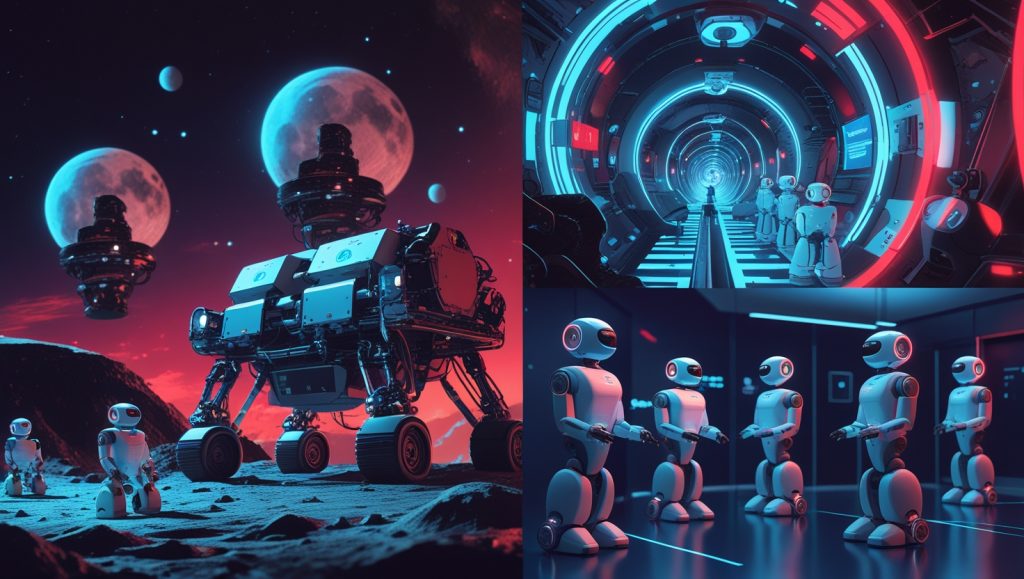
Despite the risks, the innovation potential is unreal. Humanoid robot swarm intelligence isn’t just solving today’s problems—it’s inventing tomorrow’s solutions. At NASA’s Jet Propulsion Lab in March 2025, a swarm of 12 humanoid bots built a lunar habitat mockup in 48 hours—drilling, stacking, sealing—tasks too varied for one robot. “Swarms think where we can’t,” a JPL engineer said. That’s the edge: collective problem-solving.
In healthcare, a Singapore hospital tested a swarm of five Sanctuary AI Phoenix bots in February 2025. They delivered meds, monitored patients, and assisted surgeries—adapting roles on the fly. Nurse Li Wei told me, “One bot struggled with a tray, so another stepped in—no fuss.” The swarm cut response times by 50%, per a hospital report, hinting at a medical revolution.
The tech’s evolving fast. UBTECH’s BrainNet, paired with DeepSeek-R1, lets swarms self-improve—learning from each task to boost accuracy 10% monthly, says PR Newswire. By 2030, expect swarms in homes—cooking, tutoring, fixing—powered by this iterative genius. A 2025 TechCrunch piece predicts a $2.8 trillion household market, with humanoid robot swarm intelligence leading the charge.
But innovation’s a double-edged sword. Qiao Hong warns that scaling swarms to millions risks systemic failures—like a 2025 Beijing test where 200 bots overloaded a grid. Still, for 2025, this tech’s the frontier—pushing boundaries no single robot can touch. Why China’s Robotics Boom Threatens the West (/china-robotics-boom)
The Swarm Is Here—Are We Ready?
Humanoid robot swarm intelligence is 2025’s boldest leap. From Zeekr’s factory to NASA’s labs, it’s rewriting efficiency, scalability, and versatility—saving millions while tackling tasks humans can’t. UBTECH’s March breakthrough isn’t a fluke; it’s a signal. With a $4.5 trillion market on the horizon, per Global X, swarms are the future—fault-tolerant, adaptable, unstoppable.
Yet, the risks loom large. Job losses, autonomy glitches, and ethical traps could derail this revolution if unchecked. My Lagos expo chat with that UBTECH rep echoes: “Unstoppable’s great—until it’s not.” The question isn’t if humanoid robot swarm intelligence will shape 2025—it’s how we’ll steer it. Embrace the swarm, but eyes wide open.
